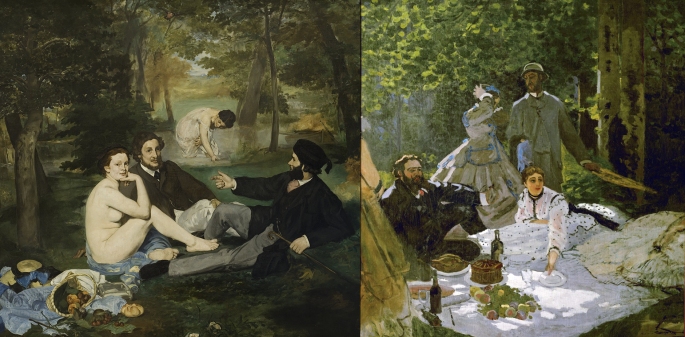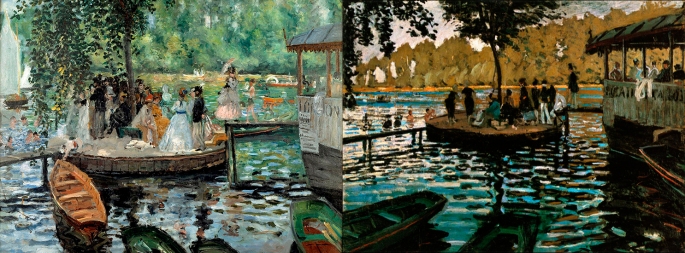Charles Sanders Peirce once noted that it is an achievement of human excellence to see the world as an artist. What he meant is to see the world as it really appears, and specifically not as we conceptualize it. Similarly, Claude Monet once said of his friend and fellow painter Edouard Manet, “He comes to paint the people, I have come to paint the light.” This comment speaks volumes about what we see when we see what we see. If that sounds confusing it is because what we see remains constant but what we see it as can change. Monet and Manet were in the same place and painting the same scene, but they painted it vastly differently because Manet was painting the concepts as he knew them while Monet was painting the phenomena as he experienced it.

I want to explore what that means. What did Peirce have in mind when he drew his distinction between phenomena and concept. I suspect that to see the world “like an artist” is to see the world precisely devoid of concepts. That is to peel back every single layer of cognition. We often think of this as what “the eye” sees, or what we see without the “mind’s eye”. Phenomena, we take to be primary to human cognition, like Immanuel Kant, from whom I take the word. The phenomena for Kant came from the unknowable noumena or the thing-in-itself. The noumena–if there is such a thing–is the thing outside of our experience of it, an object before we experience it. Kant held noumena to be beyond our ability to know. Human knowledge, he claimed, is limited to what we experience, that is phenomena. We do not see a chair, for example, what we see is patches of color in a familiar shape we “recognize” as a chaise lounge. We do not hear a song, we hear frequencies of airwaves, that we recognize as Bon Jovi.
This stands against many long-held theories of epistemology and human cognition. The traditional view, since John Locke anyway, is simply that we experience the world through our senses, and those senses give us reliable information, which we then conceptualize into the things we know. This picture, I believe, is completely backward.
No doubt our senses present us with reliable phenomena, qua phenomena, but that is not really what we experience. What we experience are concepts; concepts mapped onto the phenomena before or at the same time we experience them. Really, the human phenomenal experience is all about mapping concepts. Concepts are all we’re concerned with. When I look at a table and chairs, I don’t see colors and shapes and tints and shades and other static phenomena, even though all these are what we might say my eyes can “see”. When I look at a table and chairs, I see a “table and chairs”, that is the concepts “table” and “chairs” applied precognitively to the phenomena. I didn’t have to think about it. I didn’t have to ask myself, “what is that?” and answer myself, “that is a table and chairs”. I simply saw a table and chairs. Whatever part of my mind applies the concepts I know to the phenomena I experience, does so without the acknowledgment of my conscious mind. And what is more, I’m satisfied with my knowledge of the table and chairs because I can apply “table” and “chairs” to the phenomena of my eyes.
To really see what I mean, let’s examine this from another angle. Look at children’s drawings the world over and you will see art, not as the artist sees the world, but as the rationalist see it. The child draws the world of concepts. The humans they depict have the right parts to make them visually identifiable as human: one head, round; two eyes, in the center of the head; one nose underneath the eyes and one mouth underneath the nose; a body; two arms; two legs; perhaps hands with five fingers each; feet; perhaps even a heart. There is nothing of “realism” in the child’s work. Every child is a minimalist. What is relevant here is that to “see the world as an artist” is to unlearn what comes so natural to us that even very young children can do it: seeing the world in concepts.

It is important to note that when we see the world in concepts, we are the ones applying the concepts, but we do not create the concepts. We take them from our experience of the unconceptualized world and our culture. When we don’t know what something is, what we mean to say is we have no conceptualization for the pattern of phenomena we are experiencing. Lacking a concept, we don’t even have a name for what we experience and so we are reduced to gesture, verbal or physical, and wonder. The child’s primordial and perennial question, “What’s that?”, is the basis of all human understanding. It is from this question that we build up batteries of concepts into the storehouse of knowledge.
The real point here is that human beings apply the concepts we see and we apply them in such a way that we do not recognize our own hand in their application. We experience them as out there in the world, coming to us through our eyes. But this is both false and dangerous. It is because of this inconspicuous application that we experience our own biases as “natural”. We cannot see ourselves standing before the light and so see our shadow as something manifest in the world. This gap between what we see and how we see it is perhaps the greatest source of epistemological error. The gap is perilous to transverse when dealing with observable phenomena, but it is doubly perilous when the phenomena in question must be inferred from the phenomena that can be observed, for here we must jump the gap twice!

